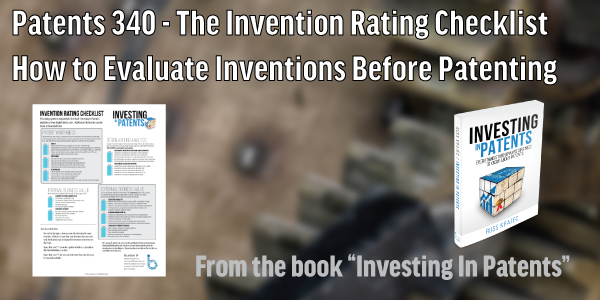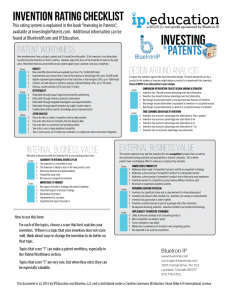Picking Inventions Is Hard
Picking Inventions to Patent Are Very Hard Decisions – When Done Well
These are painfully hard decisions – when done well.
It may seem weird that I say that.
Isn’t the decision easy? I have an idea and I need to get protection?
Don’t I just call a patent attorney and have them take care of everything?
Well, actually no.
Most patents are worthless. In fact, probably over 90% of them are worthless.
For every worthless patent, someone spent a small fortune with their patent attorneys while at the same time giving up their most precious trade secrets.
The sad part is that most entrepreneurs believe that they are “protected” once the patent is filed, so they start acting as if they were.
They don’t understand that their patent is ridiculously narrow but they are making decisions thinking that they are on solid ground.
Doing patents well is about finding the 5 or 10% of patents that have real commercial value.
This means having a well thought out strategy at the very beginning, then messaging that strategy as we learn new things about the technology and the market.
As we walk through the checklist, you will see the different factors that make up a good patent.
You will get a sense of how difficult it is to find an invention that will be a good business asset to your company.
There is a lot of uncertainty when it comes to deciding whether or not to protect an idea, how to protect it, and the best strategy to build your protection and your business.
One of the big uncertainties is whether or not the idea will have commercial value.
Obviously, we hope so, but there is a lot of risk that the technology will even work and that the market will see value in it.
There is a lot of inherent risk in the patent system as well.
For almost everyone – including patent attorneys – the patent system has some element of mystery.
None of us can tell if a patent will issue. And it is even harder to know if that patent will have value when it does.
If the stars align, your patent could be worth millions – even billions – of dollars.
If not, you might build a huge business around the technology, only to lose everything when you try to enforce a lousy patent –
Or when an acquiring company does due diligence on you and decides that they can get around your patent very easily.
On the other side of the coin, I hear countless stories from people who invented something but never got a patent.
They regret not getting a patent when it would be worth millions now.
What is the right thing to protect? When should I do it? How should I do it?
What experience has taught me is that I am wrong far more often than I am right.
With the high level of uncertainty, it is really tempting to just close your eyes, plow straight ahead, and “trust your gut.”
When I find myself wanting to trust my gut, it usually means that I am avoiding doing the hard work to make a good decision.
There are countless success stories of an entrepreneur taking a huge risk and succeeding.
But there are a thousand other stories of entrepreneurs making the wrong decision and failing.
When I started financing patents, I thought I could just trust my gut.
I was shocked by how hard it is to pick the winners from the losers.
I told this to a friend who has been a venture capital investor for over 20 years.
He said that you have to lose 30 million dollars just to figure out how to invest in startups.
Many of my angel investor friends tell the same story.
It is along the same lines as Malcom Gladwell’s 10,000 hours to become a true expert at something.
The checklist has become part of the decision making process that I use on a day to day basis to evaluate new inventions and to do the due diligence prior to any investment.
Like with all decisions that are made in business, we can reduce the risk of a decision by performing experiments or tests to see if we are right or wrong.
Many companies do a minimum viable product to verify their technology and gauge customer response.
If that is successful, they invest a little bit more money.
The checklist is a similar tool.
We want to run the invention though a gauntlet to see how well it stands up.
The better it does, the more we like it.
When we use the checklist internally, we think about it as reducing our uncertainly – reducing our risk.
The checklist is just another tool to bring us back to reality.


